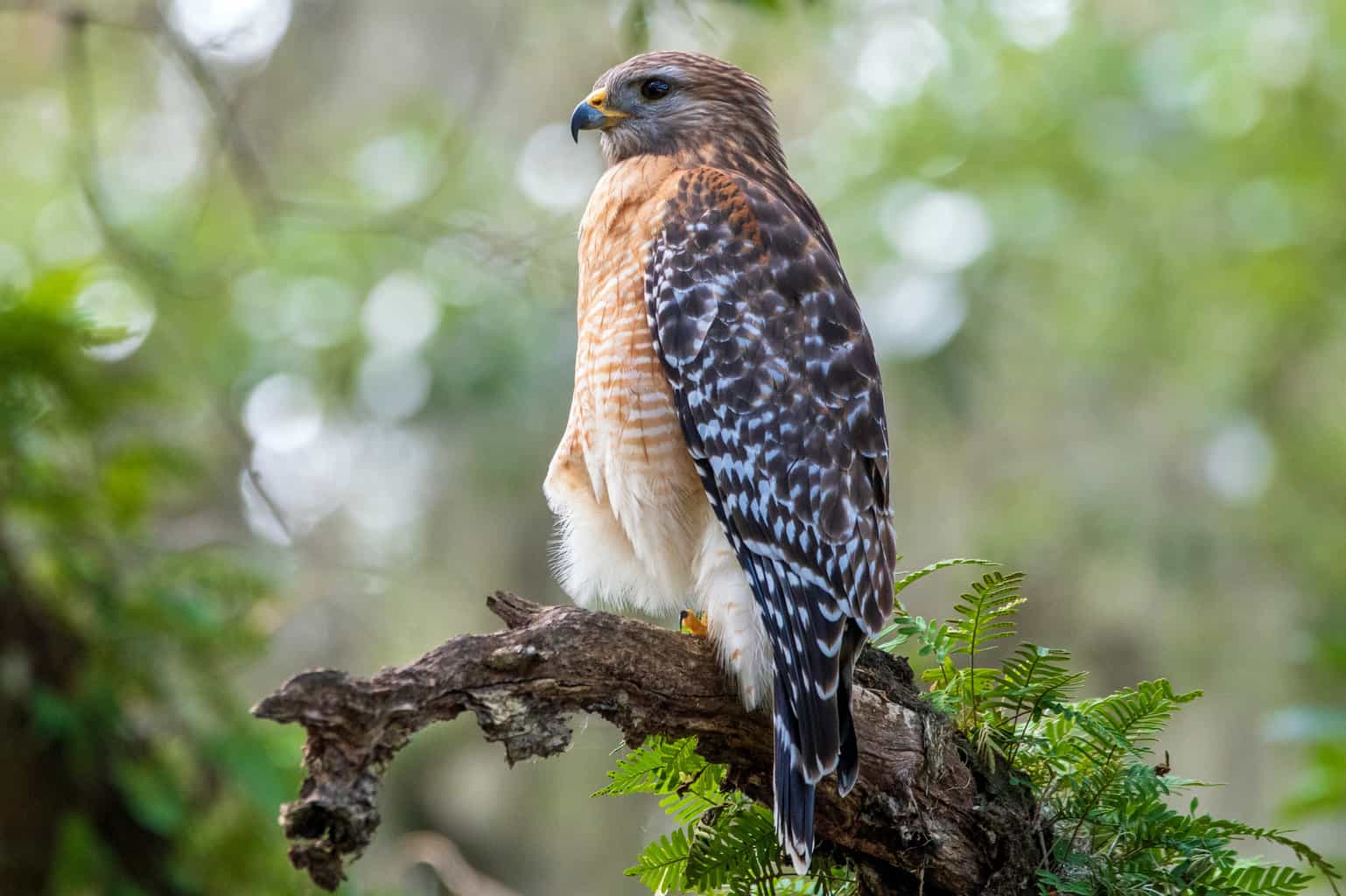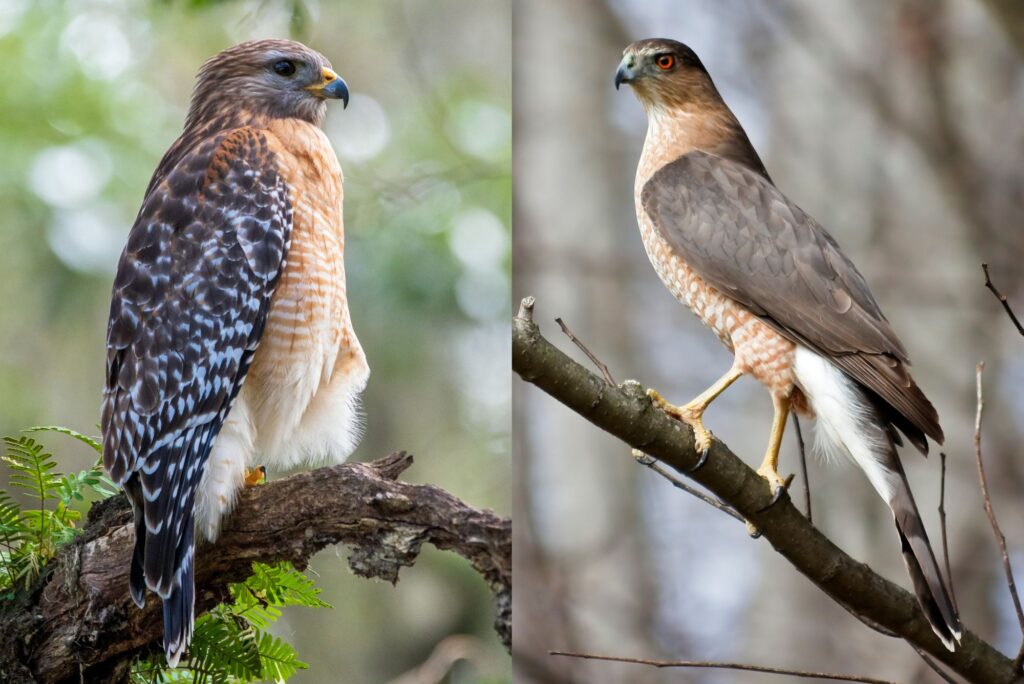If you spot hawks flying over your head, you may wonder which species of hawk you’re seeing. The red-shouldered hawk and Cooper’s hawk are two hawk species found in the United States. Fortunately, it is relatively easy to tell these two species apart.
What is a Red- Shouldered Hawk?
The red-shouldered hawk, Buteo lineatus, is a member of the Buteo genus, commonly called buzzards in other parts of the world.

Before 1900, the red-shouldered hawk was among the most common North American raptors. Population densities have decreased precipitously, primarily due to deforestation and habitat loss. Habitat loss remains the biggest threat to red-shouldered hawks today.
What is a Cooper’s Hawk?
The Cooper’s hawk (Accipiter cooperii) is a true hawk in the Accipiter genus. The other two North American species in this genus are the smaller sharp-shinned hawk (Accipiter striatus) and the larger northern goshawk (Accipiter gentilis).

Today, the Cooper’s hawk is thought to number around 800,000 in the United States and Canada. And despite serious threats to its health and habitats, populations are considered strong and have resurged in the 21st Century.
How Do You Tell the Difference Between the Red-Shouldered Hawk and Cooper’s Hawk?
When trying to identify a hawk, there are several different areas to look at:
- Where you see the bird (geography and habitat).
- The size of the bird in question.
- The anatomy of the bird.
- The color of the bird’s plumage.
- The sounds the bird makes.
Where Red-Shouldered Hawks and Cooper’s Hawks Are Found
Red-shouldered hawks are primarily found in the eastern US and along a narrow coastal range down the coast of California. So if you see a hawk outside those areas, it is more likely to be a different species.
They prefer to stay in forest or woodland areas and can also be seen in suburban areas with forest or woodland zones.
The Red-shouldered hawk is a permanent resident throughout most of its range, though northern birds do migrate, primarily to central Mexico.
Cooper’s hawks live almost throughout the contiguous United States, except for some parts of the southern Great Plains, a bit of northwestern Maine, and northernmost Montana.
They are also a forest species and tend to nest in temperate deciduous and mixed forests. They are also adaptable in all seasons to forested mountainous regions, especially foothills. In denser forest areas, these hawks prefer easy access to open spaces and, sometimes, waterways and forest edges are critical hunting grounds.
The Cooper’s hawk is also much more likely to be active in the morning than in the afternoon.
The Cooper’s hawk is a partial migrant. They tend to be most migratory in the north and sedentary elsewhere.
Red-Shouldered Hawk and Cooper’s Hawk Size Comparison
Red-shouldered Hawk:
- Length: 38-61 centimeters
- Weight: around 700 grams
- Wingspan: 90-127 centimeters
Cooper’s Hawk:
- Length: 35-50 centimeters
- Weight: 215-701 grams
- Wingspan: 62 to 99 centimeters
Both species’ females are larger than the males. Cooper’s hawk females can be about 20% longer and 40% heavier. The Cooper’s hawk’s size also varies significantly depending on geographical location.
Size and weight are not the easiest way to tell these birds apart, but the red-shouldered hawk is, on average, a little larger and heavier than most Cooper’s hawks.
Anatomical Differences Between the Red-Shouldered Hawk and Cooper’s Hawk
Red-shouldered hawks have moderately long tails and flap their wings like Accipiters, a point of difference from other birds in the Buteo genus but no different than Cooper’s hawk.
Cooper’s hawks have moderate-length wings, a long, often graduated or even wedge-shaped tail, and long though moderately thick legs and toes. Their eyes are set well forward in the sides of the relatively large and squarish-looking head, and they have a relatively short but robust hooked bill.
Both of these birds have long tail feathers, but the Cooper’s hawk’s wingspan is more rounded than the much more angular shape of the Red-shouldered hawk’s tail.
A Cooper’s hawk is easily distinguished from buteonine hawks (like the red-shouldered hawk) because these other hawks possess much longer wings and shorter tails.
Plumage Differences Between the Red-Shouldered Hawk and Cooper’s Hawk
By far, the easiest way to tell the difference between these two hawks is by looking at the coloration of their plumage. Even the juveniles of these species vary greatly in plumage.
Red-shouldered hawks have brownish heads, reddish chests, and paler bellies with reddish bars. Their tails are marked with narrow white bars. Adults’ wings are also strongly barred, and when the birds are perched, the reddish ‘shoulders’ that give the bird its name are apparent.
Cooper’s hawks, as adults, are a solid blue-gray or brown-gray color above, lacking the rufous coloration of the red-shouldered hawk. Adults usually have a well-defined crown of blackish-brown feathers above a paler nape and hindneck.
Their tails are blue-gray on top and pale underneath, barred with three black bands in an even pattern and ending in a rather conspicuous white tip. They have white fronts with irregular cinnamon-hued banding.
Hearing the Difference Between Red-Shouldered Hawk and Cooper’s Hawk
Another key way to tell the difference between these birds is by their calls.
The red-shouldered hawk sounds a two-note call, which is higher and clearer in tone. The second note descends in pitch, and this noise is typically repeated several times in a row. These birds may call in this way while in flight or while they are perched.
The typical call of a Cooper’s hawk is a harsh, cackling yelp. Observers describe it as “keh-keh-keh.” The males tend to have a higher pitched, less raspy, and faster-paced call than females.
Other Related Birds Compared To Red-Shouldered Hawks or Cooper’s Hawk
Though the red-shouldered hawk and the Cooper’s hawk can occasionally be confused with one another when not clearly viewed, it is far more common to confuse each of these species with other birds, either in the Buteo or Accipiter genii.
The juvenile red-shouldered hawk is most commonly confused with young broad-winged hawks. However, you can identify the red-shouldered hawk by its long tail, crescent-like wing markings, and a more flapping, Accipiter-like flight style. This hawk is also sometimes confused as an adult with the more common red-tailed hawk.
The Cooper’s hawk is far more difficult to distinguish from other Accipiter species than it is from those in the Accipiter genus.
Cooper’s and sharp-shinned hawks are very similar (sometimes considered almost identical) in plumage characteristics at all stages of their development. However, there are some differences to look for.
The northern goshawk is another bird easily confused with Cooper’s hawk. But when comparing Cooper’s hawk to these other two Accipiters, it is notable that Cooper’s hawks typically have the longest tail and the shortest wings of the three.

